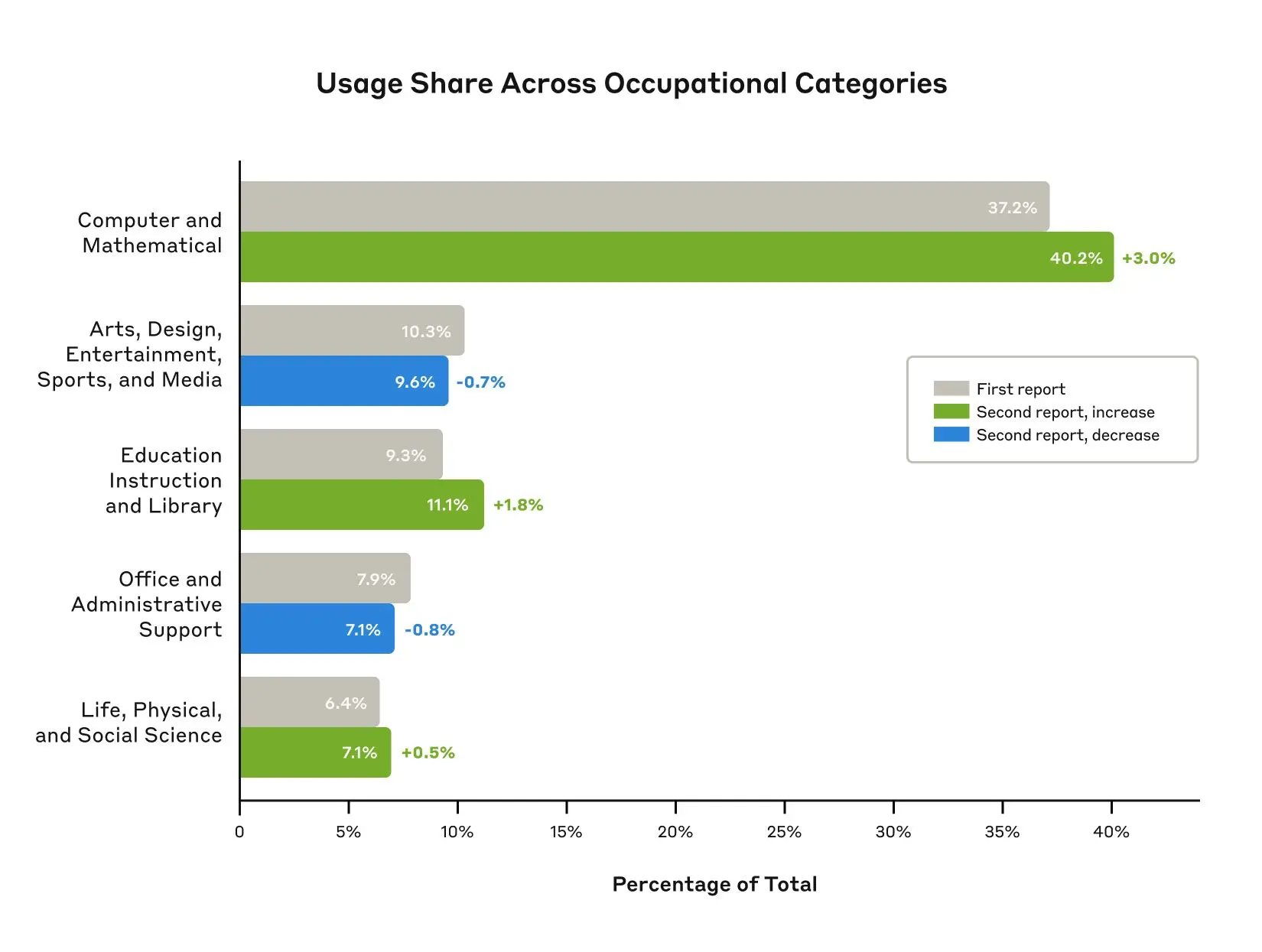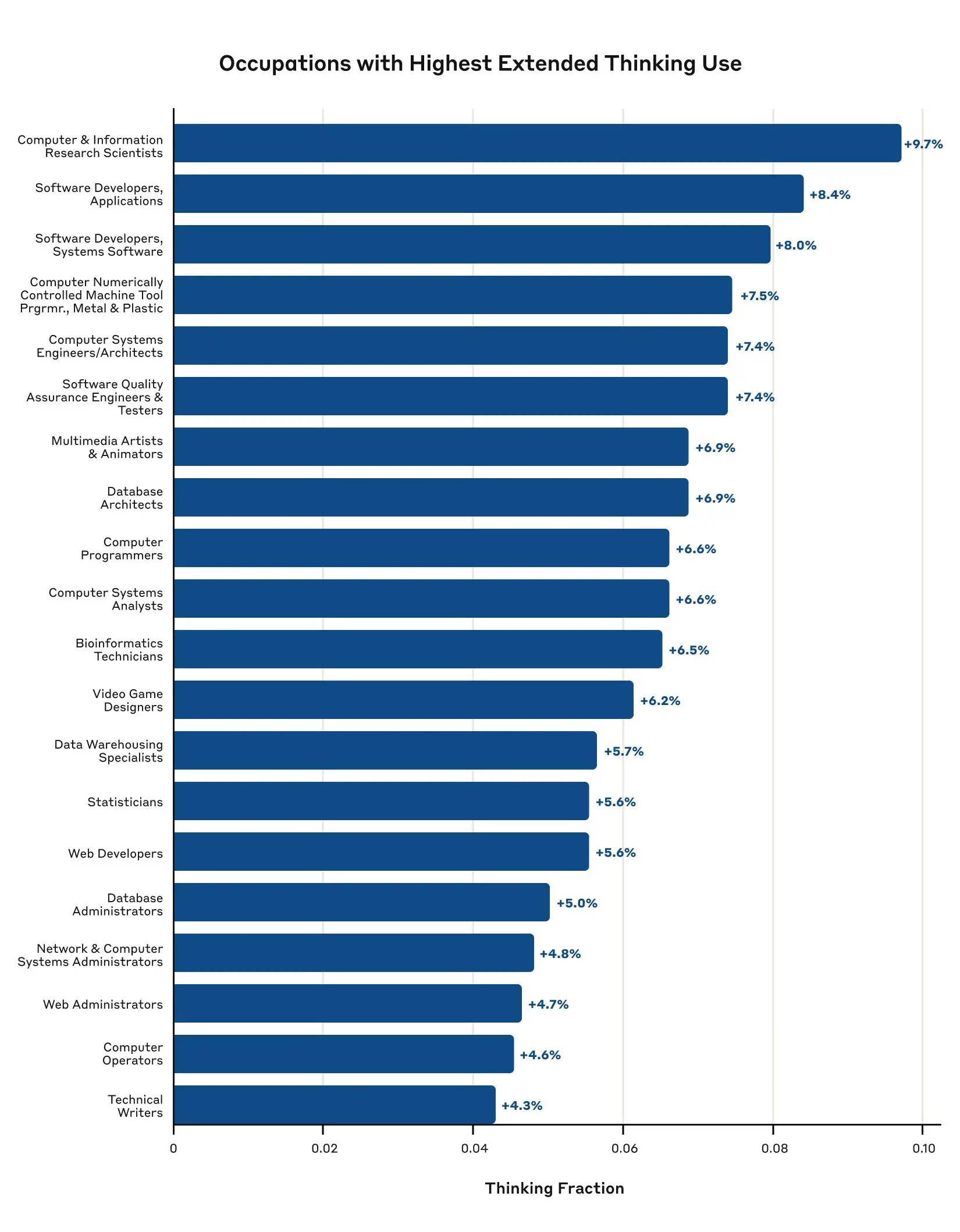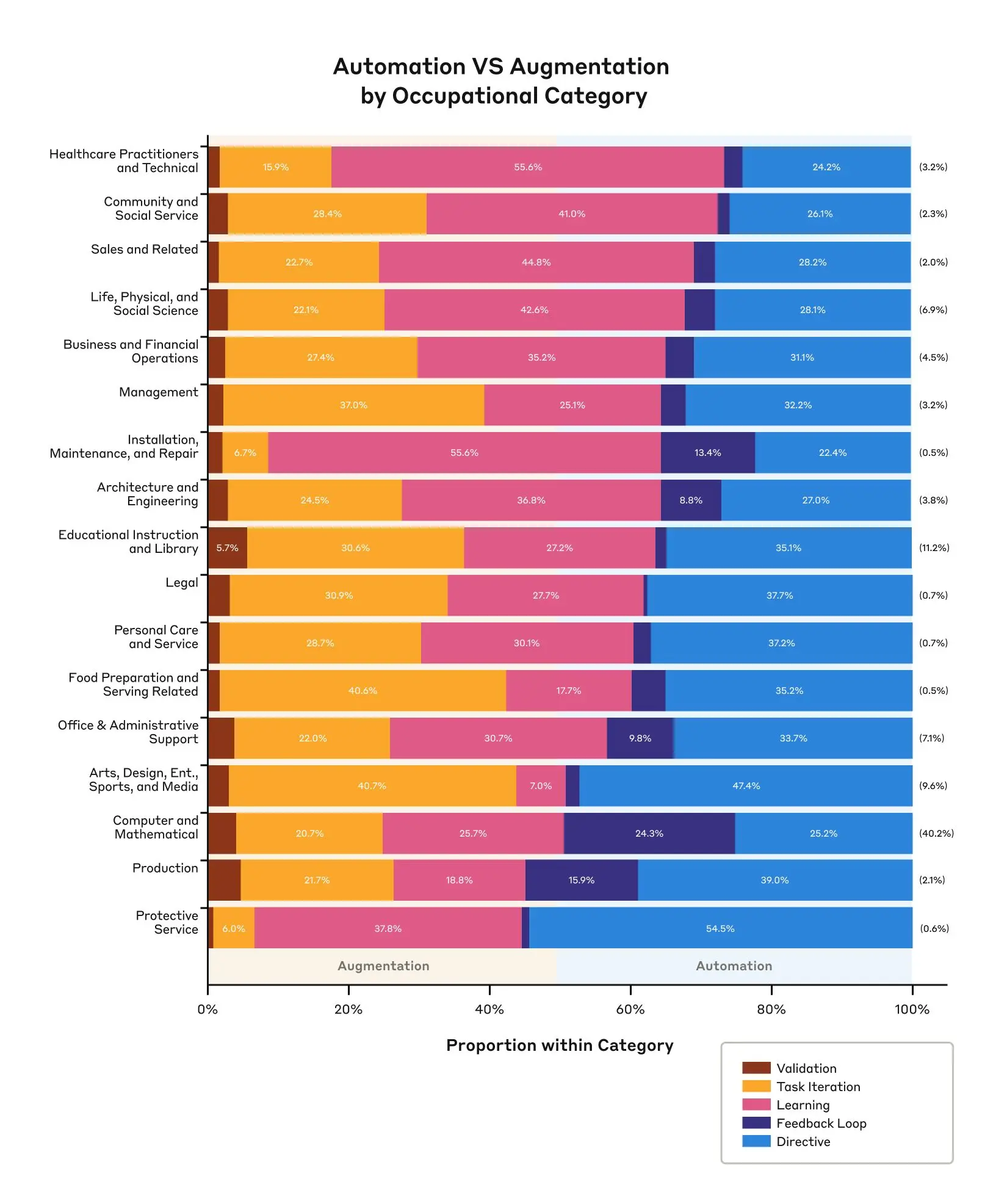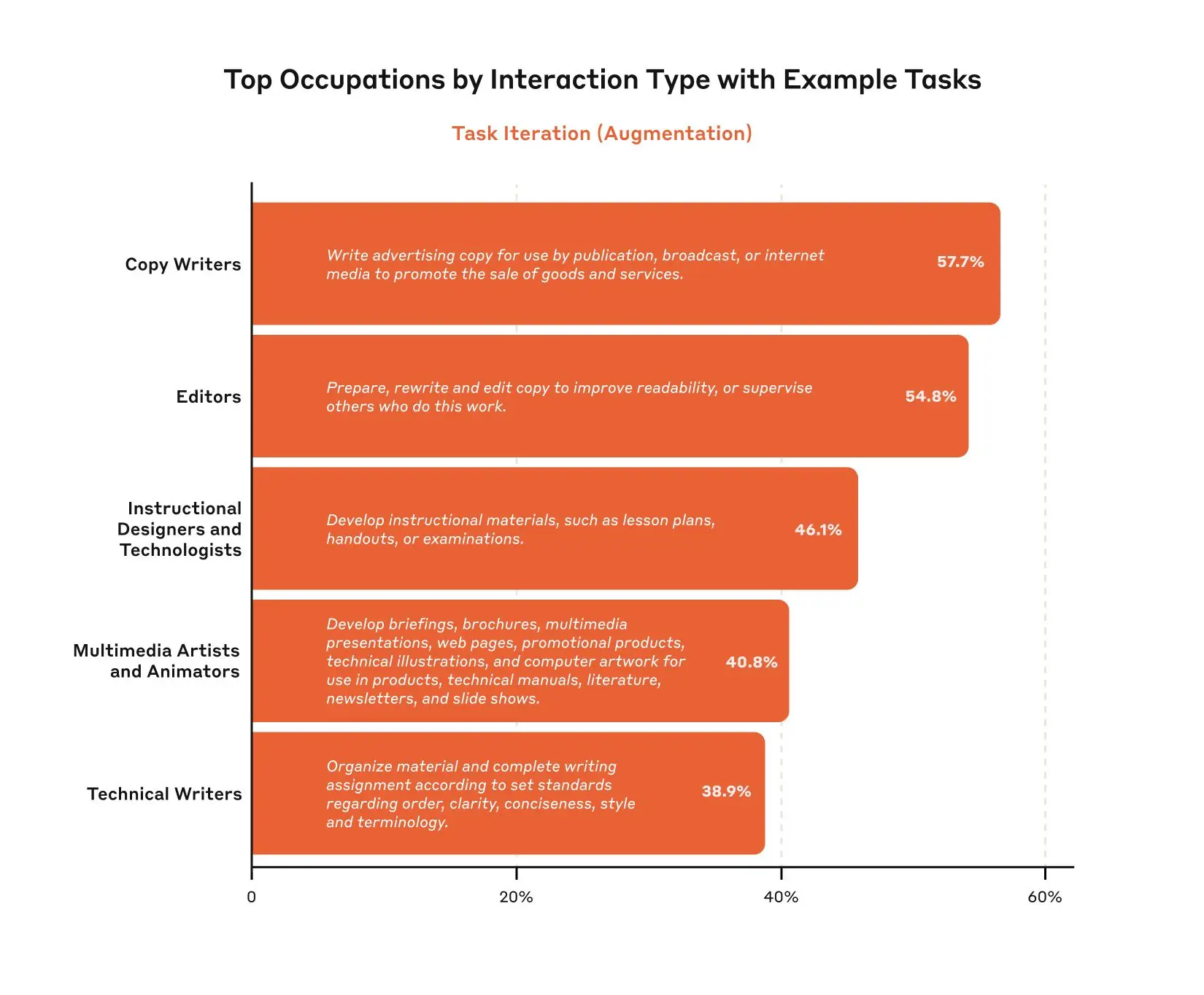Updated: March 28 2025 08:48Anthropic's recent release of data from their
Economic Index provides fascinating insights into how their latest AI model, Claude 3.7 Sonnet, is being used across different sectors and occupational categories. The findings reveal surprising patterns about AI adoption, task automation, and human-AI collaboration that can help us better prepare for an AI-integrated future.
This latest report, the second in the series, analyzes user interactions following the launch of Claude 3.7 Sonnet—Anthropic's most advanced model to date. The model introduces several new capabilities, most notably an "extended thinking" mode that enables the AI to think for longer periods when tackling complex questions. The research examines one million anonymized conversations on Claude.ai, providing a comprehensive picture of how users are leveraging the technology across various domains.
Key Findings: What's Changed with Claude 3.7 Sonnet
The data reveals several significant shifts in user behavior since Claude 3.7 Sonnet's launch. Most notably:
- Changing Usage Patterns: There's been a measurable increase in the proportion of usage related to coding, educational applications, scientific tasks, and healthcare. This shift likely reflects both Claude 3.7 Sonnet's improved capabilities in these areas and the ongoing diffusion of AI adoption across various sectors.
- Extended Thinking Mode Applications: Users predominantly employ the new "extended thinking" mode for technical problem-solving. Tasks associated with computer science researchers, software developers, multimedia artists, and video game designers show the highest usage rates of this feature.
- Augmentation vs. Automation Balance: While the overall balance between augmentative and automative uses remains stable at 57% augmentation, there has been a notable increase in learning interactions (from ~23% to ~28%), where users ask Claude for information or explanations on various topics.
- Occupation-Specific Usage Patterns: The data breaks down usage patterns by occupation, revealing that tasks associated with copywriters and editors show high rates of task iteration (human-AI collaboration), while translator and interpreter tasks demonstrate higher directive behavior (where the AI completes tasks with minimal human involvement).
Evolving Usage Patterns Across Sectors
The data shows modest but noticeable increases in several key areas:
- Coding applications have seen the most significant increase, which aligns with Claude 3.7 Sonnet's improved performance on coding benchmarks.
- However, the growth in educational and scientific applications suggests either a broader diffusion of AI usage throughout the economy or unexpected capability improvements in the model that make it more valuable for these domains.
- Interestingly, some categories have seen decreased usage shares, though this reflects proportional changes rather than absolute declines. This shifting distribution indicates how rapidly user preferences and applications evolve as AI capabilities advance.
Extended Thinking Mode: A New Frontier for Complex Tasks
Claude 3.7 Sonnet's new "extended thinking" mode represents a significant advancement in AI capability, allowing the model to spend more time processing complex problems. The data shows this feature is being embraced primarily for technical and creative problem-solving tasks:
- Computer and information research scientists lead with almost 10% of their associated tasks using extended thinking mode
- Software developers follow at around 8%
- Multimedia artists and animators show approximately 7% usage
- Video game designers demonstrate about 6% usage
This concentration in technical and creative fields suggests that extended thinking mode is most valuable for solving complex problems that require deeper analysis or creative ideation. It's particularly interesting that both technical fields (computer science) and creative occupations (multimedia artists) show high adoption rates, indicating the versatility of this feature across different types of complex cognitive tasks.
To support further research into this capability, Anthropic has
released a dataset mapping each task to its associated thinking mode fraction, allowing researchers to explore more nuanced patterns in how extended thinking is being utilized.
Augmentation vs. Automation: How Humans and AI Collaborate
The overall balance between augmentation and automation has remained relatively stable since the previous report, with augmentation still comprising 57% of usage. However, there has been a shift within different types of augmentation, with learning interactions (where users ask Claude for information or explanations) increasing from approximately 23% to 28%.
When broken down by occupational categories, interesting patterns emerge:
- Community and Social Service tasks, which include education and guidance counseling, show the highest proportion of augmentation at nearly 75%. This suggests AI is primarily serving as a supportive tool rather than a replacement in these human-centered fields.
- In contrast, production or computer and mathematical occupations show a more balanced split between augmentation and automation, approaching a 50-50 ratio. This may reflect the more technical and procedural nature of many tasks in these fields.
- Perhaps most notably, no occupational category shows automation dominating over augmentation. Even in fields where automation is higher, such as translation services, the pattern suggests AI is still being used primarily as a collaborative tool rather than a replacement for human workers.
Task-Level Analysis: Who's Iterating and Who's Directing
Diving deeper into specific occupations and tasks reveals fascinating patterns in how humans interact with AI:
- High Task Iteration: Tasks associated with copywriters and editors show the highest amount of collaborative iteration, where the human and AI work together to develop and refine content.
- High Directive Behavior: Tasks associated with translators and interpreters show among the highest rates of directive behavior, where the AI is given instructions to complete a task with minimal human involvement.
- Learning Interactions: Librarians show the highest proportion of learning interactions at approximately 56%, suggesting AI is frequently used as an information resource in this field.
These patterns reveal how AI's role varies significantly across different professions. In creative fields like copywriting, AI serves as a collaborative partner in an iterative process. For more structured tasks like translation, AI can function more independently under human direction. And in information-focused roles, AI primarily serves as a knowledge resource.
Implications for the Future of Work
What do these findings tell us about AI's impact on the economy and labor markets?
First, the persistence of augmentation over automation across all occupational categories suggests that AI is currently functioning more as a collaborative tool than a job replacement technology. This aligns with research suggesting that AI may be more likely to transform jobs than eliminate them entirely.
Second, the concentration of extended thinking mode usage in technical and creative fields indicates that advanced AI capabilities may be particularly valuable for complex problem-solving rather than routine tasks. This suggests AI could help address skill shortages in fields requiring specialized technical expertise.
Third, the growth in educational and scientific applications points to AI's potential as a tool for knowledge dissemination and research acceleration. If this trend continues, it could significantly impact how knowledge work is conducted across numerous fields.
Finally, the detailed task-level analysis reveals that AI's integration varies substantially across different workflows and professional contexts. This suggests that AI's economic impact will be highly heterogeneous, affecting different occupations in distinct ways rather than having a uniform effect across the economy.
What's Next for AI Economic Research
Anthropic's work represents an important step forward in understanding AI's economic impact, but many questions remain. As noted in their conclusion, they plan to continue tracking these metrics and developing new ones as capabilities improve and models are applied across the economy. Key areas for future research might include:
- Longitudinal analyses tracking how usage patterns evolve as AI capabilities advance
- More detailed studies of how AI affects productivity and job quality in specific sectors
- Research on how AI usage varies across different demographic groups and organizational contexts
- Analysis of how regulatory frameworks and ethical guidelines shape AI adoption and impact
The findings from this latest report suggest that while AI adoption continues to expand across different sectors, the relationship between humans and AI remains predominantly collaborative rather than substitutive. As AI capabilities continue to advance, ongoing research like Anthropic's Economic Index will be essential for tracking how these technologies are reshaping economic activities and preparing for the future of work.
Recent Posts






